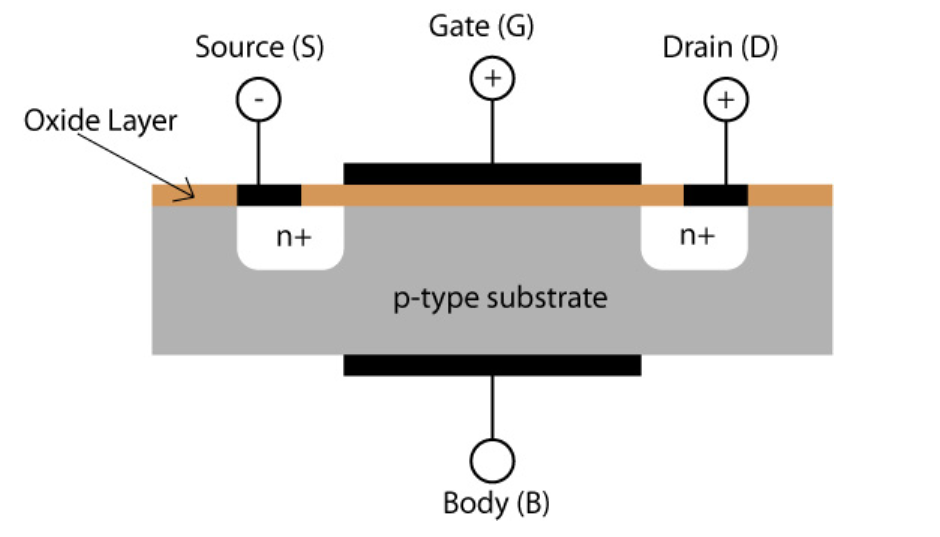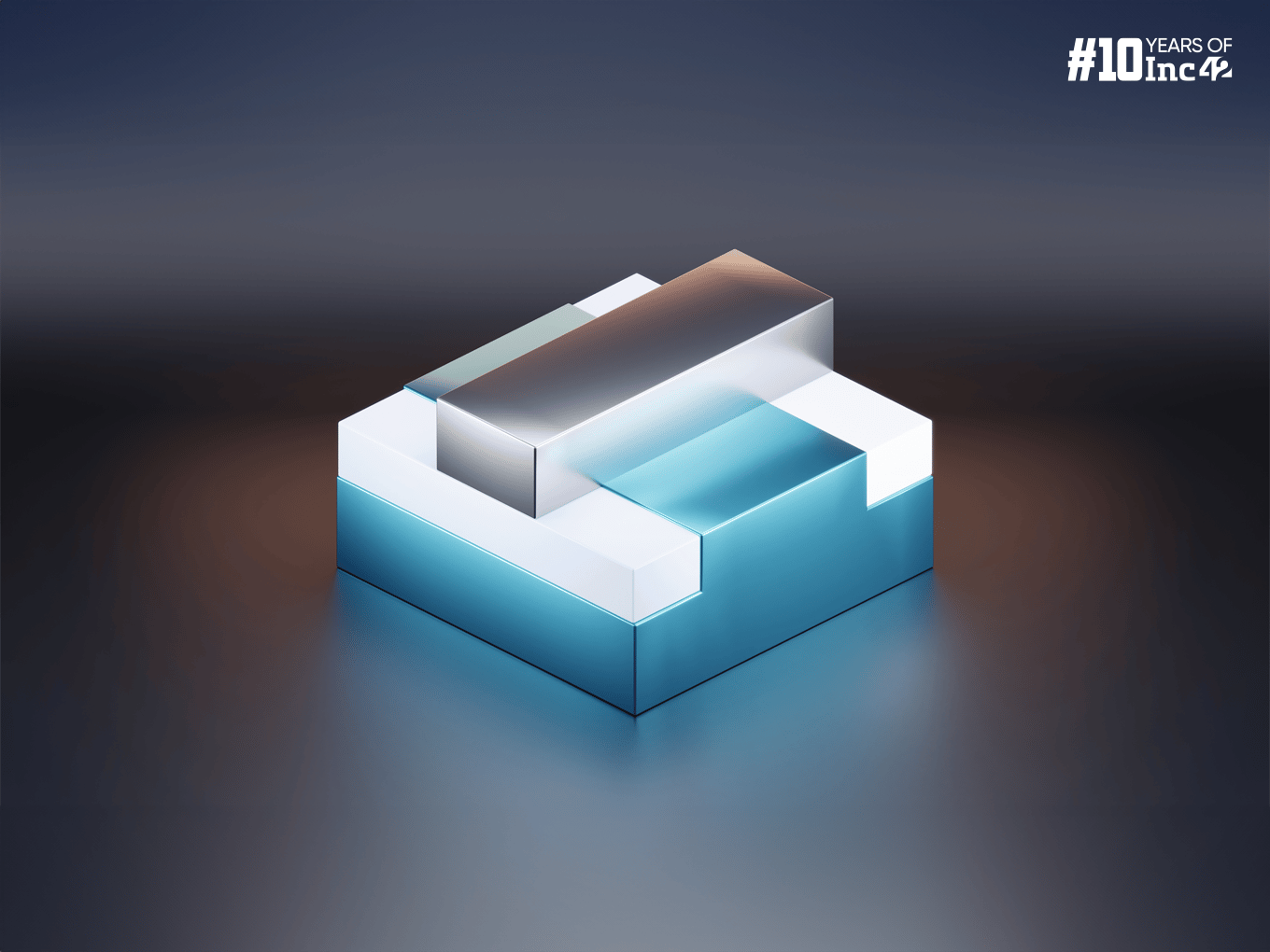What Is MOSFET?
A Metal-Oxide-Semiconductor Field-Effect Transistor (MOSFET) is a fundamental building block of modern electronics. It is a field-effect transistor (FET) where the voltage applied to a terminal (gate) modulates the conductivity of a channel formed between the drain and source terminals.
A doped semiconductor material (such as silicon) is used to create a gate, and its conductivity depends on the electric field generated by the voltage on the gate. The insulating layer, usually silicon dioxide, between the gate and the channel allows for control of the channel’s conductivity with minimal gate current.
How Does A MOSFET Work?
A MOSFET works based on the concept of a metal-oxide-semiconductor capacitor and modulation of the conductivity between two terminals.
- Structure: Imagine a sandwich with three layers:
- Bottom layer: A semiconductor body (either p-type or n-type)
- Middle layer: A thin insulating oxide layer (usually silicon dioxide)
- Top layer: A metal gate electrode
- MOS Capacitor: The gate and the body act like a capacitor because of the insulating oxide layer. By applying a voltage (Vgs) between the gate and the source (usually connected to the body for simplicity), an electric field is created across the oxide.
- Channel Formation (N-Channel MOSFET):
- In an N-channel MOSFET, when a positive voltage is applied to the gate (Vgs), it repels the majority of holes (positive charges) near the oxide in the p-type body. This creates a region depleted of holes called the depletion region.
- If the voltage is high enough, it attracts electrons (negative charges) from the source towards the gate, forming a thin layer of n-type conductivity called the inversion layer. This creates a channel for current to flow between the drain and the source.
- The higher the Vgs, the wider the channel and the more current can flow.
- Depletion & Enhancement Modes: There are two main types of MOSFETs based on channel formation:
- Enhancement Mode: In this mode, a minimum voltage threshold (Vth) is applied to the gate to create the inversion layer and turn the transistor on. Below Vth, the channel is depleted, and minimal current flows (acting like an open switch).
- Depletion Mode: A small channel already exists due to body doping. A zero or negative gate voltage is needed to deplete the channel and turn it off (acting like a normally closed switch).
- Current Flow: By adjusting Vgs, one can control the channel’s width and hence, the amount of current that can flow between the drain and source.
The gate voltage acts like a valve, controlling the current’s flow between the drain and the source.

What Are The Four Types Of MOSFET?
There are two main ways to categorise MOSFETs – by their channel type and by their conduction mode.
Channel Type
- N-Channel MOSFET (NMOS): This is the most common type. It has a majority carrier current of electrons flowing through an n-type channel. N-channel MOSFETs turn on when a positive voltage is applied to the gate relative to the source.
- P-Channel MOSFET (PMOS): Less common than NMOS, P-channel MOSFETs have a majority carrier current of holes flowing through a p-type channel. They turn on when a negative voltage is applied to the gate relative to the source.
Conduction Mode
- Enhancement Mode (Depletion-less): This is the most widely used mode. In this mode, no channel exists between the drain and source when zero voltage is applied to the gate. A minimum voltage threshold (Vth) is applied to the gate to create a channel and turn the transistor on. This mode is similar to a ‘normally open’ switch.
- Depletion Mode (Normally-Close): In this mode, a thin channel already exists due to the body doping, even with zero gate voltage. Applying a zero or negative voltage to the gate depletes the channel and turns the transistor off. This mode is similar to a ‘normally closed’ switch.
The following is a table for a better understanding:

What Are The Applications Of MOSFET Within Semiconductors?
MOSFETs are fundamental building blocks in modern semiconductors due to their ability to function as both switches and amplifiers. Here are some applications of MOSFETs:
Digital Integrated Circuits (ICs)
- Logic Gates: The foundation of digital circuits, logic gates like NAND, NOR, AND, and OR are built using complementary pairs of MOSFETs (CMOS). N-channel (NMOS) and P-channel (PMOS) transistors are combined to create low-power logic circuits.
- Memory Chips: MOSFETs are essential components in various types of memory chips, such as Dynamic Random-Access Memory (DRAM) and Static Random-Access Memory (SRAM). They act as memory cells, storing information by controlling the flow of current.
- Microprocessors: Microprocessors rely on millions or even billions of MOSFETs to perform calculations and execute instructions. They are used for logic operations, data storage, and signal processing within the microprocessor.
Analog Circuits
- Amplifiers: By adjusting the gate voltage, MOSFETs can control the current flowing through the drain and source terminals. This allows them to amplify weak electronic signals. Depending on the operating region, they can be used in various amplifier circuits like voltage or current amplifiers.
- Analogue Switches: MOSFETs can function as electronic switches, routing or blocking analogue signals based on the voltage applied to the gate. This enables functions like signal selection or signal gating in analogue circuits.
Power Electronics
- Power MOSFETs: Designed for high-power handling, these are used for switching and controlling large currents. Applications include power supplies, motor drives and switching circuits in various electronic devices.
Other Applications
- Image Sensors: CMOS image sensors, commonly found in digital cameras and smartphones, utilise MOSFETs to convert light into electrical signals.
- Radio Frequency (RF) Circuits: Specially designed RF MOSFETs are used in amplifiers, mixers, and other components of RF circuits for applications like wireless communication.








